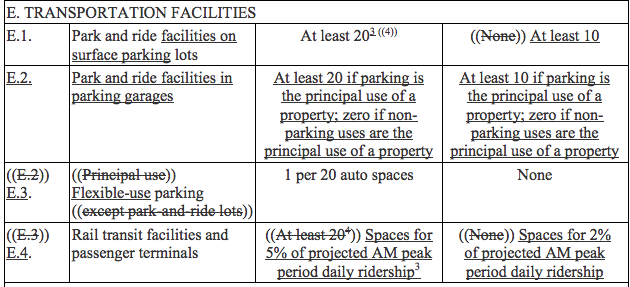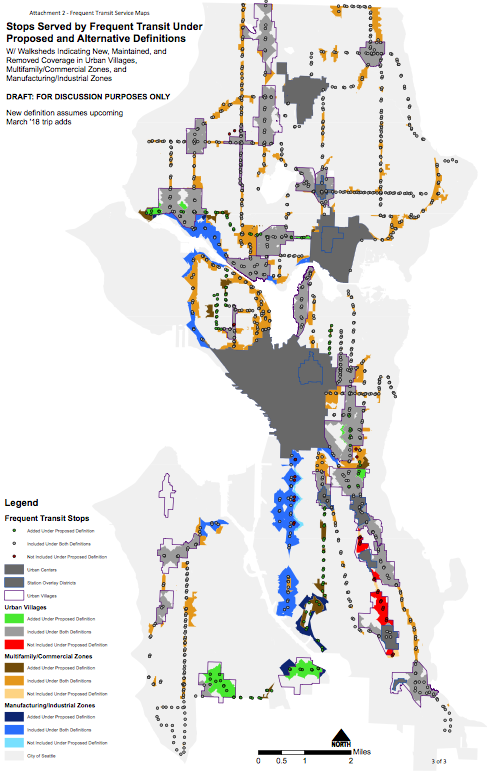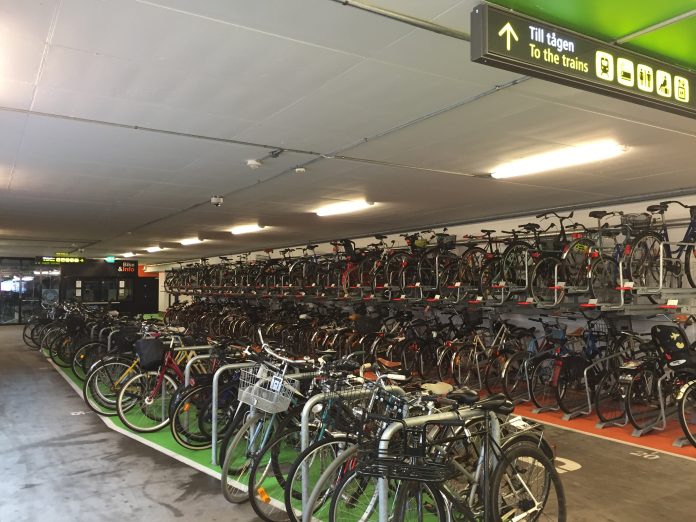Off-street parking reform could come to Seattle soon. The city council is considering package possible changes recommended by the Mayor ranging from increasing bicycle parking requirements and unbundling vehicle parking from leases to modifying the definition of “frequent transit service” and allowing more shared parking. A public hearing on the proposal is planned for Wednesday at 9.30am in the City Council Chambers.
Councilmembers have already discussed some possible amendments to the proposal. These include further modifications to the proposal related to bicycle parking requirements and definition of frequent transit service.
Floor Area Ratio Exemptions Related to Bicycle Parking
Bicycle parking and associated requirements would generally increase under the reform proposal. In zones outside of Downtown, these spaces would not be exempt from floor area calculations. Similarly, the proposed bicycle parking requirements would include a provision for bicycle commuter showers in large office developments with more than 100,000 square feet. In zones outside of Downtown, these spaces would not be exempt from floor area calculations. Possible amendments would make these facilities fully exempt in all zones where required.
Bicycle Parking Ratios

For most uses, bicycle parking ratios would increase. These ratios are based upon best practices by the Association of Pedestrian and Bicycle Professionals but often exceed the recommended amounts, according to Council Central Staff. However, the proposed ratios are similar to the numbers used in Vancouver, British Columbia and Portland, Oregon. Council Central Staff notes that Portland is currently considering adjustments to their standards that are tiered based upon geographic location and modal split goals. An amendment similar to that approach could be possible instead of sticking with the proposed one-size-fits-all approach by use.
Adjusting Bicycle Requirements for Transit Providers
King County Metro Transit and Sound Transit have expressed concerned with how proposed bicycle requirements might affect their light rail and park-and-ride facilities. Under the proposal, several different minimum bicycle parking requirements would apply to transit facilities. Sound Transit, for instance, is now using a variety of approaches to bicycle parking, including bike lockers and bike cages. The transit agencies also wants to encourage more turnover of its limited bicycle facilities. However, peer cities globally provide much higher amounts of bicycle parking options. Possible amendments could allow city departments to modify bicycle parking requirements for transit agencies based upon projected demand.
Defining Frequent Transit Service

The definition of “frequent transit service” would be altered under the parking reform proposal to solve challenges in implementation encountered by projects today. The existing definition has led to many challenges for recent development proposals where developers sought flexibility and relief from higher off-street parking requirements. Under interpretations by the city hearing examiner, transit service frequency intervals cannot be assessed based upon schedules nor averaged resulting in more complex analysis of real-world service operation.
The Land Use Code would primarily rely upon a new Director’s Rule by the Seattle Department of Construction and Inspections to indicate with stops and map areas that qualify under the definition. Generally, these are areas within a quarter-mile (1,320 feet) of a transit stop that is served by one or more routes each arrive at high frequency intervals.
Unlike the current method, the Director’s Rule could be modified to allow for some variance in intervals through averaging, which is an acknowledgement that schedules and actual arrivals may be several minutes on either side of a targeted frequency (e.g., every 15 or 30 minutes).
To assist in understanding what changes to the definition of frequent transit service could mean, a map has been prepared (see right). Some areas theoretically could eliminated by the proposed definition, but in practice, the proposed definition would provide certainty that a particular site qualifies for reduced or eliminated off-street parking requirements. The proposed definition would also add new areas.
Several amendments could change the direction of the definition:
- Eliminate proposed changes. One option is to simply eliminate any change to the definition.
- Definitive definition. Another option is adopt a new definition addressing various issues with the existing instead of solely relying up a Director’s Rule.
- Mapped definition. The city council stick with a definition in Land Use Code–whether amended or the same–while relying upon on maps interpreting the definition adopted by Director’s Rule as the sole source defining “frequent transit service.”
- Prohibit averaging. The city council could explicitly prohibit the practice of averaging trip intervals in the calculation of transit service frequency.
- Actual service frequency. The city council could specify in the definition that frequent transit service must be calculated on actual service frequency experienced on the ground, not just in a schedule.
- Scheduled service frequency. The city council could require that the definition of frequent transit service simply rely on scheduled service frequency.
The ramifications of any one choice could be quite substantial in allowing or not allowing developments to reduce or eliminate their off-street parking requirements. There are considerable impacts that off-street parking policies can have on air and water pollution (i.e., more parking induces car ownership and leads to environmental degradation), public health and safety, and affordability since developments with higher parking requirements generally mean fewer dwelling units can be built raising the average price of housing. The city council will have to weigh these priorities as they reach consensus on a final ordinance.
Deep Dive: SDCI’s Draft Proposal to Improve Parking Availability
Stephen is a professional urban planner in Puget Sound with a passion for sustainable, livable, and diverse cities. He is especially interested in how policies, regulations, and programs can promote positive outcomes for communities. With stints in great cities like Bellingham and Cork, Stephen currently lives in Seattle. He primarily covers land use and transportation issues and has been with The Urbanist since 2014.



